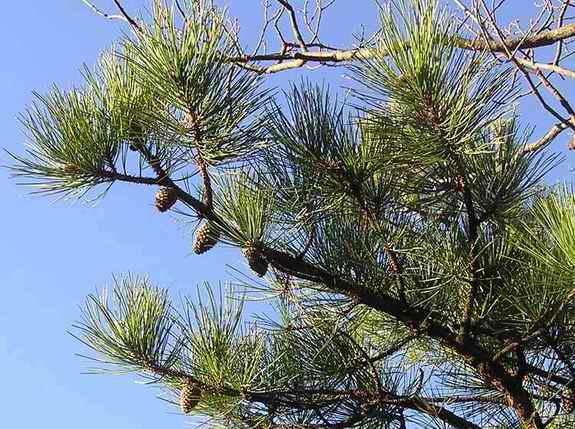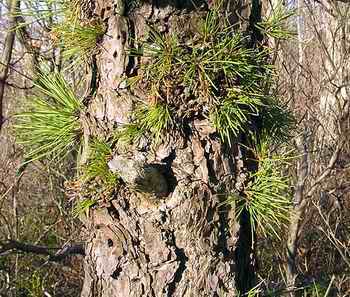|
Return to Hiker's Notebook Home Page
Common Name: Pitch Pine, Hard pine, Bull pine, Black pine, Pin a feuilles rigides (French for the pine with rigid leaves). Scientific Name: Pinus rigida (Genus Pinus is Latin word for pine, species from Latin rigidus meaning unbending or stiff for the cone scales and for the rigid needles)
Pitch Pine is characterized by stiff, yellow-green needles that are in bundles of 3 with lengths ranging from 3 to 5 inches. The other pines that are within the same range have either 2 or 5 needle bundles. The cones are attached almost directly to the branches, having no stems, a configuration known as sessile. It is not tolerant of shade and favors shallow, sandy soils, such as those found on steep slopes and ridges, primarily at elevations between 1500 and 4500 feet. It shares the same habitat as the Virginia pine (P. virginiana) and the Table Mountain pine (P. pungens)
The name Pitch Pine derives from its high resin content relative to other pines (32 pounds per cubic foot), pitch being an alternative word for the viscous organic resin derived from pine trees. The tree was of great importance to the early colonists, who observed it being used by Native Americans as a source of light. Called candlewood or fatwood, Pitch Pine heartwood was cut into short lengths and used as "splint light." The Reverend Francis Higginson of Salem, Massachusetts opined in 1633 that " � such candles as the Indians commonly use, having no other, and they are nothing else but the wood of the pine tree cloven into little slices, something thin, that are so full of moysture of turpentine and pich that they burn as cleare as a torch."
The Pitch Pine was also of strategic importance as one of the materials needed to build and maintain the British fleet of wooden sailing ships. The term "naval stores" was originally used to refer to all materials so employed, including cordage, resin, tar and timber. The richness of the resins of the Pitch Pine was recognized by the earliest colonists. The first recorded cargo of naval stores left the Virginia colony of Jamestown for Great Britain in 1608.
The traditional source of naval stores for the British Navy was Scandinavia. When that source was cut off by the Russian invasion of Sweden-Finland in the early 18th Century, Britain turned to its North American colonies as its primary source of naval stores. The industry became a mainstay of colonial commerce and the pitch pines were cut down so quickly in the New England colonies that the naval stores industry moved to the Carolinas, whence the name "tar heel" for North Carolinians derives.
The term "naval stores" in current usage refers to products obtained from the resin of pine trees. Gum naval stores are obtained by tapping pine trees (similar to rubber tree tapping), sulphate naval stores are obtained by converting pine wood chips to pulp by the sulphate process, and wood naval stores are obtained by solvent extraction from resin-saturated pine stumps. The resins are distilled to produce rosin, a non volatile, brittle, transparent, glassy solid and turpentine, the distillate. These two products are used primarily in making soap, paints, varnishes, and as inputs to the chemical industry for a wide range of products including fragrances, flavors and vitamins. The southern slash and loblolly pines are currently the primary sources for naval stores in the United States.
Pitch pine is a polymorphic species, i.e. it has two different morphologies, or forms. Trees can have either serotinous (late in developing) or nonserotinous cones, but not both on the same tree. The nonserotinous cones open soon after maturity, which occurs about 18 months after pollination from the male pollen cones. The winged seeds, about 75 per cone, are dispersed by the wind from November to April. Serotinous cone seeds are not released until after a fire, contributing to the Pitch Pine's fire resilience. The two types of trees are geographically separated, the serotinous trees occurring in fire prone habitats.
Pitch Pine is noted for its ability to survive adverse conditions, even if all of the needles are destroyed by fire. This is attributed to thick bark that protects the underlying cambium, rapidly growing sprouts, extensive root systems, and the presence of dormant buds that are contained in the trunk and at the base of the tree. These buds will sprout if the crown is destroyed, even after the tree has matured beyond 50 years. For this reason, prescribed burning is an important management tool in Pitch Pine forests, as its successional competitors are eliminated. |

